|
Some basics for bootmen

Cowboy (Western) Boots |
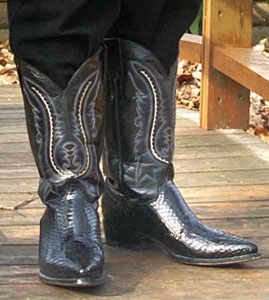 |
Cowboy Boots (also known as Western boots) refer to a specific
style of riding boot, historically worn by cowboys. They usually have a
high heel, rounded to pointed toe, high shaft, and no lacing. Cowboy
boots are normally made from cowhide leather but are also sometimes made
from "exotic" skins such as alligator, snake, ostrich, lizard, eel,
elephant, stingray, elk, buffalo, and the like.
|
| |
There are four types of Cowboy Boots: |
| |
| WESTERN RIDING BOOTS |
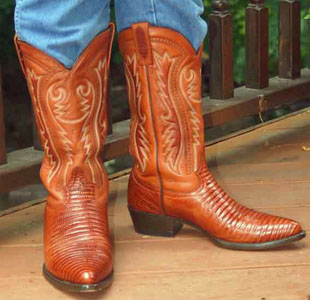
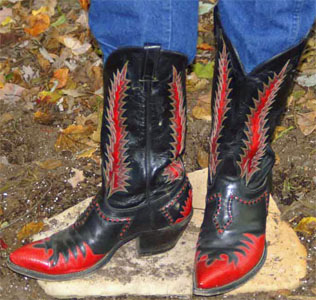
| Western boots can be customized with a wide variety
of toe shapes, they are usually made with a pointed toe. However, there are
as many as 12 toe shapes,
ranging from "X" (very narrow pointed) to "W" (wide, round). Most cowboy boots
have the "L" toe, which is pointed but not as narrowly as X.
Another distinguishing factor of a cowboy boot is the angled heel, and
heel height. The heel itself is a mark of nobility. The earliest information
about the high heel being used for riding describes invading Mongol tribesmen
wearing bright red wooden heels. Mongols were consummate horsemen and their
easy victories left a mark on European society. Since owning and caring for
a horse requires some wealth, and since being on horseback places a person
physically above the common man, riders and, consequently, high heels, became
associated with nobility. To this day, we say well-heeled to describe someone
who is wealthy. Standard cowboy boots of today have heel heights of 1-1/4" to
1-3/4", and most have a thin rubber sole pad. There are as many as 13 heel types,
ranging from a straight block (like Frye Boots), to
walking, riding, and underslung -- the latter being the most angled and highest.
Soles of cowboy boots are usually made of smooth leather.
The final distinguishing mark of a western riding boot is the scallop, or how
the boot shafts are finished at the top. There are as many as eight scallop types. The
most common is a full scallop, which is a "V" pattern cut across the front and back
of the boot shaft. Flat scallops (or stovepipe style) are also common.
|
| |
| BUCKAROO BOOTS |
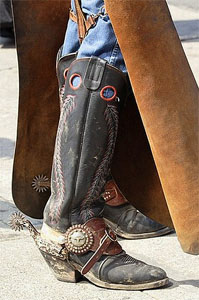 |
Buckaroo Boots get their name from the men who wore
them, the California vaquero, a type of Spanish or Mexican cowboy who
worked with young, untrained horses. The California vaquero or
buckaroo, unlike the Texas cowboy, was considered a highly-skilled
worker, who usually stayed on the same ranch where he was born or had
grown up and raised his own family there. Cowboys of this tradition
were dubbed buckaroos by English-speaking settlers. The term buckaroo
officially appeared in American English in 1889.
The Buckaroo's Boots are tall, ranging from 15" to 20" or up to the
knee. They are usually two-tone, and many have multi-colored stitching
on the foot and shaft. They usually have a deep scallop and pull holes
instead of straps. |
| |
| ROPER BOOTS |

| The roper style has a more rounded heel, usually
one inch or shorter, and will have the heel extend straight down. Roper
boots are usually made with rounded toes, but some new styles have a
more squared toe. |
| |
| PACKER BOOTS |

| Packer Boots were originally worn by enlisted soldiers in
the U.S. Army in the 1800's who would not make a career out of military service,
but muster out of service in the west. The packer boot is suited for farm and
ranch footwear, and was made for people in the Rocky Mountains working with
packhorses (thus the name). Form and functionality make these boots the
preference of outdoorsman everywhere.
These are lace-up boots, and are usually 10" high, but fasion packers can
be taller, as high as the knee. They have a kilty (false tongue) and are
made of very durable, thick leather. Most packer boots are brown, but they
are also available in black and other colors. They usually have rubber,
neoprene, or sometimes Vibram® soles.
|
| |
| HISTORY OF COWBOY BOOTS |
| A cowboy needed to be able to quickly
and surely mount and dismount his horse in the course of work. In
addition to working cattle, they also worked and trained new horses.
Much of their riding was cross-country, conditions were rough and
unpredictable, and weather variable from summer heat to winter snow.
Staying alive and comfortable under these conditions drove the mutation
of the cavalry and other tall riding boot designs into what has come to
be called the "cowboy boot".
Most histories of the cowboy boot agree they were derived from the
cavalry boot used in the Civil War in the early 1860s and other similar
designs. Working cattlemen in the 1870s and 1880s asked bootmakers for
modifications to better fit their working conditions. Predictably,
most of these bootmakers were in the cattle ranching areas of Texas,
Oklahoma, and Kansas. The two most renowned bootmakers of the era were
Charles Hyer of Hyer Brothers Boots in Olathe, Kansas, and H. J. "Big
Daddy Joe" Justin of Justin Boots in Spanish Fort, Texas and later
Nocona, Texas.
Read much more detailed history of the Cowboy Boot.
|
| |
| COWBOY BOOT DESIGN |
| While mounting, the slick, treadless
leather sole of the boot allowed easy insertion of the foot into the
stirrup of the Western saddle. While an extremely pointed toe is a
modern stylization appearing in the 1940s, the toe of the original boots
retained the more rounded shape of other boots. A slight point to the
toe does make it somewhat easier to quickly insert the foot in the
stirrup, but an extremely pointed toe is not helpful and not practical
in a working boot.
While mounted, the tall heel prevented the foot from sliding forward
through the stirrup, which could be life threatening if it happened and
the rider were to be unseated. The tall shaft, comfortably loose fit and
lack of lacing might save a cowboy's life since his body weight would
pull his foot out of the boot if he were unseated and his boot remained
stuck in the stirrup.
While dismounting, the slick sole allows the boot to easily come free
of the stirrup.
The tall leather shaft of the boot helped to hold it in place in the
absence of lacing. While mounted, the shaft protected the leg from
saddle rubbing, brush and thorns. While dismounted, the shaft helped
protect the leg and foot from rocks, brush, thorns, and snakes. In wet
weather or creek crossings, the high tops helped prevent the boot from
filling with mud and water.
|
| |
| FANCY COWBOY BOOTS |
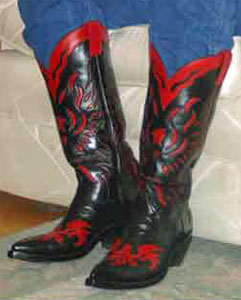
|
Decoration of cowboy boots varies widely.
Early boots were plain leather, but as custom boots were made, cowboys
asked for decorative stitching, cutouts in the high tops (early on,
often Texas stars), and different materials. Modern cowboy boots are
available in all colors of the rainbow and a pair has been made from
just about every animal whose skin can be made into leather.
|
| |
| SPURS ON COWBOY BOOTS |
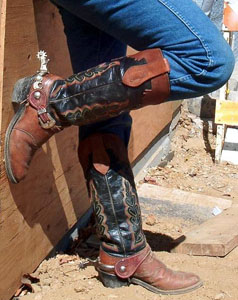
|
One accessory used with cowboy boots is a
pair of spurs, which is sometimes attached to the heel of each boot for
the purpose of goading the horse while riding. Spurs rest on a ledge
called a spur ridge at the top of the heel where it is attached to the
boot. The spur ridge keeps the spur from sliding down the back of the heel.
|
| |
| FITTING OF COWBOY BOOTS |
| Many cowboy bootmakers have been in
operation since the 19th century. Their ability to stand this test of
time has often depended on their ability to understand the human foot
and how to keep people's feet comfortable. Each manufacturer has
developed its own proprietary lasts for producing boots, which are
considered trade secrets and are highly guarded. Because of this,
standardization has been slow, and fitting between companies is not
always consistent. When considering wearing a cowboy boot from a
different manufacturer, it is recommended to seek assistance from a
knowledgeable merchant who specializes in cowboy boots. Some wearers
will swear by one manufacturer's fit, while others will not perceive any
difference between brands.
The fit will vary depending on the type of toe that is sought.
Pointed toes leave a narrower space between the toes and the tip of the
boot which may cause discomfort. This is avoided by selecting a half
size larger than the wearer's normal size. A rounder toe (like a roper
or a Wellington) will fit more like a regular shoe. Another factor is
leather. A cowhide or kidskin boot will become softer with wear, molding
to the wearer's foot. That is why it is recommended to select a snug
size because the boot will eventually "break in" and a loose fit will
become sloppy.
Many men wear cowboy boots with dress as well as casual wear.
Cowboys riding horses often will wear their jeans inside their boots
which keeps dirt and mud from getting on the jeans.
|
| |
|
Content from Wikipedia, D.W. Frommer II,
and Booted Harleydude
Text from Wikipedia
article on Cowboy Boots and as edited and contributed to by Booted
Harleydude. Text of this article is licensed under the
GNU Free Documentation License.
|

Tutorial - Types of Boots
Boot Information Resources
Boot Information Page Index
|

